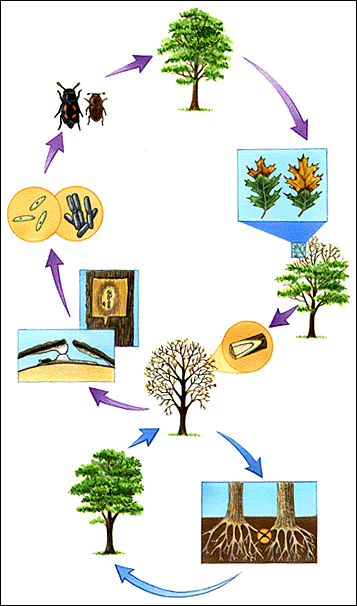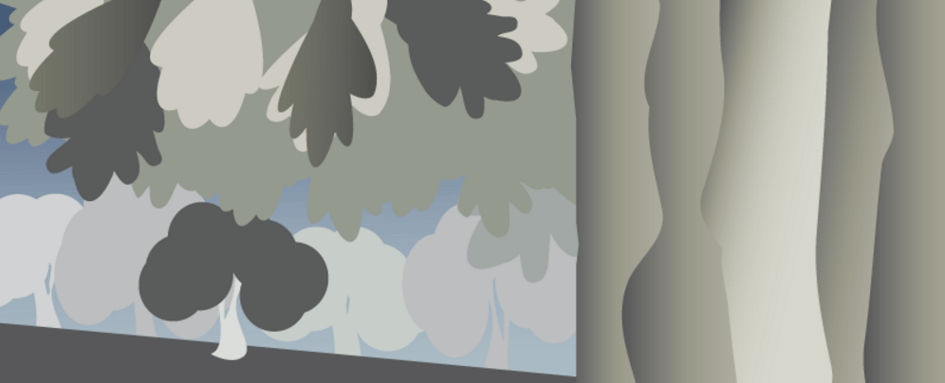Texas oak wilt is the most devastating tree disease affecting live oaks and red oaks in Central Texas, and it’s killing our valuable oak trees at epidemic proportions.
Perhaps you have seen diseased red oak trees from a distance. In summer when a landscape should be rich green, you may spot bright, autumn colored foliage in the bunch. This is not a good sign.
There are other symptoms to diagnose Texas oak wilt and steps to prevent and stop spread, which we’ll review here. Managing oak wilt disease successfully depends on first identifying it properly and then understanding how the pathogen spreads.
What does Oak Wilt look like?
 Oak wilt is an infectious tree disease caused by the fungus Ceratocystis fagacearum. The fungus essentially destroys the water supply “veins” of susceptible oak trees. It invades and disables trees’ water-conducting systems.
Oak wilt is an infectious tree disease caused by the fungus Ceratocystis fagacearum. The fungus essentially destroys the water supply “veins” of susceptible oak trees. It invades and disables trees’ water-conducting systems.
While all oaks are susceptible to oak wilt to some extent, there are some species that are widely affected and even act as conduits for spreading the tree disease.
Oak wilt takes hold quickly. A live oak can die during a one- to six-month period after initial symptoms are recognized. Some trees can survive for years as they decline. However, red oaks are severely impacted by oak wilt and can die in three to four weeks after symptoms appear.
Symptoms of Texas Oak Wilt
There are foliar (leaf) and fungal symptoms of oak wilt disease, but all formal diagnoses must be made by submitting diseased tissues to a laboratory.
Foliar symptoms in live oaks include leaves that develop yellow veins that eventually turn brown. Rapid defoliation can occur. On red oaks, young leaves in spring will wilt and turn pale green and brown. Mature leaves can turn dark green (water soaking symptom), pale green or bronze. A tree can look like fall is being forced upon it.
Fungal symptoms include the development of fungal mats, which infected areas found beneath bark. The tree-destroying fungus is found in these mats and can be spread by insects that are attracted to the sweet-smelling spores.
Some oak trees are more affected by oak wilt disease than others:
Red oaks: Particularly Texas (aka Spanish) oak, Shumard oak, blackjack oak and water oak are extremely susceptible to oak wilt disease. In fact, these species can help establish new oak wilt infections.
White oaks: While white oaks are somewhat tolerant of the tree disease, they are susceptible to the fungus. White oaks include post oak, bur oak, Mexican white oak, white shin oak, Duran oak, Lacey oak and chinkapin oak.
Live oaks: While not as susceptible to the disease as red oaks, live oak trees can be the most seriously affected because of their root formations and how the fungus attacks water-conducting systems. Their vast, interconnected root systems can carry the disease from tree to tree.
How Texas Oak Wilt Spreads
Oak wilt can spread through the fungus or roots. Infected oak trees contain “fungal mats” that form under bark, particularly in diseased red oak trees. This fungus generally forms in spring. (It does not form on live oaks.)
These fungal mats produce a fruity odor that attracts various insects — particularly sap-feeding nitidulid beetles. These beetles burrow into fungal mats in tree bark and feed on the spores. Then, they fly to other trees and transfer oak wilt, causing spread.
Texas oak wilt can also spread through tree roots, especially in live oak trees that grow in dense groups with interconnected root systems. This method of oak wilt spread can be particularly destructive. Some “infection centers” (blocks of infected trees) in Texas can spread up to 150 feet in any one direction during a year, according to TexasOakWilt.org.
Oak wilt disease also spreads when infected wood is exposed to healthy oak trees. This can happen when diseased firewood is stored near uninfected oak trees. Also, beetles can carry the disease to healthy trees that have open wounds from pruning, wind, animal damage or hail.
Preventing and Treating Texas Oak Wilt

Managing oak wilt first requires careful identification of the tree disease based on the symptoms discussed, plus a positive lab report. An integrated approach to managing Texas oak wilt is ideal. That includes: 1) preventing new infections; 2) stopping spread through roots; 3) using fungicide injections (in high-value oaks); and 4) planting resistant trees.
- Prevent new infections. Be sure all red oaks are cut and disposed of. All firewood should be burned before spring and never stored near healthy oak trees. Avoid pruning from February to June.
- Stop disease spread via roots. Trenching at least 4 feet deep and 100 feet beyond the “infection center” can help stop the spread of the disease via root systems, especially in live oaks.
- Use fungicide injections. A trained, licensed landscape professional can treat susceptible trees with propiconazole (Alamo). This treatment is usually reserved for “high value” trees.
- Plant resistant trees. Plant a diversity of tree species on your commercial property that are adapted to Central Texas and resistant to oak wilt tree disease.
Understanding Texas Oak Wilt is a Crucial Step Toward Prevention
Knowledge is, indeed, power. The best outcomes result when we are equipped with information about how oak wilt spreads, what symptoms to watch for and how to prevent and manage the devastating tree disease.
It’s always a good idea to conduct regular tree inspections on your commercial property to watch for Texas oak wilt and other tree diseases that can spread. Following proper pruning techniques is another must.
If you read this and have any reason to question whether a tree on your property is infected with oak wilt — or anything else — contact Yellowstone Landscaping Tree Care so we can help you assess the situation. Learn more about working with an Arborist here.
Request a consultation today. We’ll meet to learn more about your property and its challenges and come up with a comprehensive plan to take care of all of the details for you.
Images: Oak illustration, Oak wilt cycle


